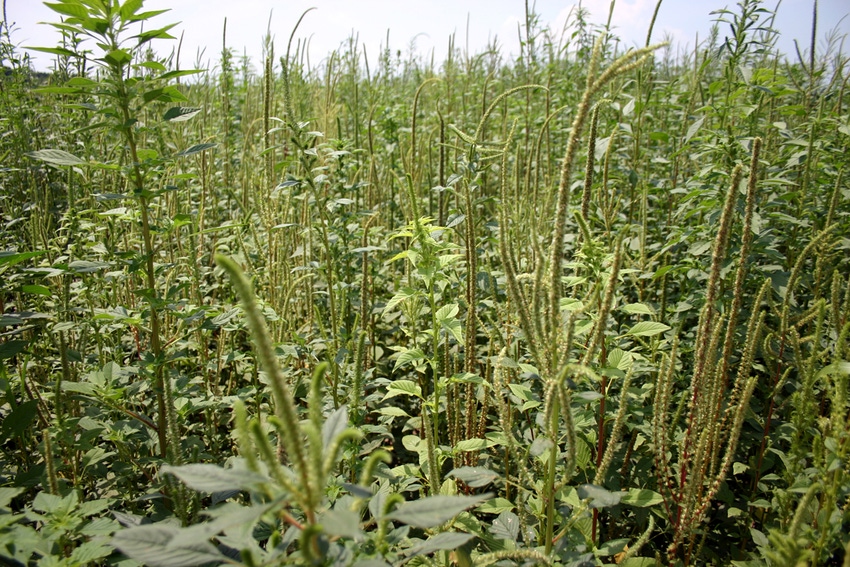
Be aware. Glyphosate-resistant Palmer pigweed may be lurking in your fields.Be informed. If you continue to stay in the Roundup Ready system, you don’t want to find out after the first glyphosate application that you have resistance.Be proactive. Using a residual in fields where you have some escaped pigweed this year is the first line of defense for control of pigweed.”

Producers who observe the three Bs — be aware, be informed and be proactive — can take a big step in controlling glyphosate-resistant Palmer pigweed in soybeans next season, according to Bob Scott, professor of weed science at the University of Arkansas.
Scott, speaking at the PigPosium in Forrest City, Ark., advised soybean producers to “think about what you saw on your farm last year, and be aware that glyphosate-resistant Palmer pigweed may be lurking out there. If you made an application of glyphosate in 2010, and you had survivors in those fields, you probably learned that we don’t have a club in our bag for the size of pigweeds that survived the first application, in conventional or Roundup Ready soybeans, or even in the new LibertyLink soybeans.”
The next step is to be informed. “Unfortunately, a lot of farmers were not informed in 2009-10,” Scott said. “They put out a quart of glyphosate. It didn’t work. They had some misses and came back with another quart and put in 0.25 ounce of Classic, or 6 ounces of Flexstar. That just made the pigweed mad. Is somebody a bad farmer for doing that? No, they’re good farmers. They were just not informed.”
Scott noted that 2010 “will be remembered as the year of the pigweed harvest. It didn’t take long to go from one or two survivors to a full-on infestation of Palmer pigweed.”
Scott says soybean producers can go from a heavy infestation to a clean field in 2011, with a proactive approach that includes residual herbicides such as Prefix, Dual, Treflan, Prowl, Authority MTZ, Valor and Valor-containing products, Boundary and Fierce (expected to be available in 2011). “All offer very good pigweed control if you get a rainfall and get them activated. Using a residual in these fields where you have some escaped pigweed this year is the first line of defense for control of pigweed.”
However, if pigweeds are both ALS- and glyphosate-resistant, “we have only one option right now, that’s fomesafen. We’re heavily relying on this class of chemistry right now, but the bottom line is if you have 2-inch to 3-inch tall pigweed, this is what I’m going to recommend.
“A second option (for ALS-resistant and glyphosate-resistant pigweed) would be either Blazer or Cobra if the pigweeds are very small.”
LibertyLink soybeans, which are resistant to Ignite herbicide, are also a new tool in the bag, but Scott stresses that residuals be used with this technology. “We don’t want to have a complete reliance on Ignite like we did with glyphosate the last 10 years, and see a development of resistance to Ignite.
Ignite in cotton, soybeans
“Trust me, the way we’ve been using Ignite in cotton and soybeans, going after large escaped pigweed, we’re asking for the development of resistance.
Scott recommends that producers avoid using Prefix (Dual plus fomesafen) pre-emergence in soybeans (because of maximum use restrictions). “Fomesafen is probably the best pigweed product I’ve looked at. In order for it to be effective on pigweeds, we need to be at the full pint to 1.25 pint rate.
“If you use your Prefix upfront and you don’t get a rain, we don’t have anything to come back with except Cobra or Blazer, and you’re going to have to be extremely early to get effective control.
“You can use other pre-emergence products like Dual, Authority MTZ, or the Valor-containing products. They’re almost as good as Prefix with a rain and in some cases can be equal. So we want to save fomesafen for our postemergence application.”
Scott recommends that growers target a 2-inch pigweed for a fomesafen (Flexstar) application. “Based on the growth rate of the weed and the growers’ ability to get across acres, it’s a good idea to start spraying when pigweeds are 1-inch tall. A day later, it could be 3 inches tall. It may be too big for Flexstar. It may be too big for Ignite in LibertyLink beans. If we use a residual, we can buy ourselves more time. You may not have to get out there as fast.”
A change in cultural practices can also help in pigweed control, according to Scott. “If you’re growing soybeans on wide rows and you know you have a resistant pigweed problem, you’re setting yourself up for a rough summer, especially in Roundup Ready and conventional soybeans. You’re leaving a lot of space out there for pigweeds to grow in, and the use of at least two residuals is in order, one early and another shot, postemergence, to fill the gap until you can get soybeans to canopy closure.”
Other cultural practices to help in pigweed control include crop rotation, water management to activate preplant or pre-emergence herbicides and seeding rates and methods.
Scott says soybean producers should not wait to find out if a pigweed is resistant. “At that point, you’re too late. You need to be proactive. Identify problem areas, get a residual out upfront, get that first early post application on the books in a timely manner.
“If you continue to stay in the Roundup Ready system, you don’t want to find out after the first glyphosate application that you have resistance. At that point, we don’t have a lot of recommendations. Unfortunately, that’s where we were on a lot of farms in 2009-10.”
About the Author(s)
You May Also Like





